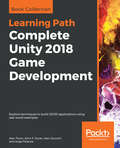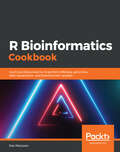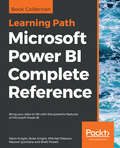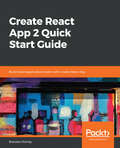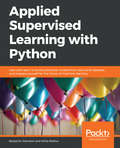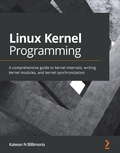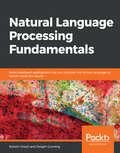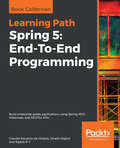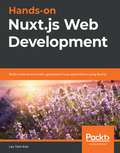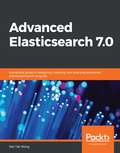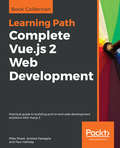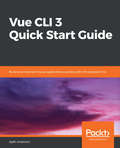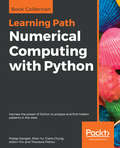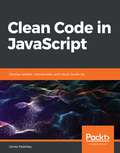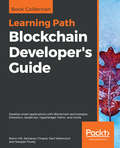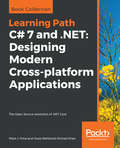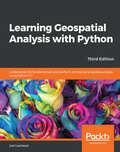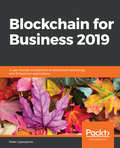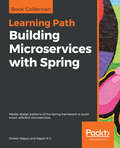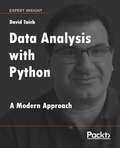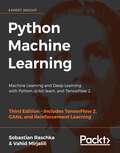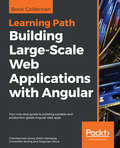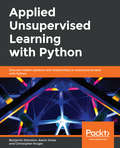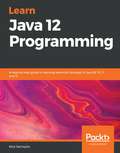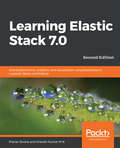- Table View
- List View
Complete Unity 2018 Game Development: Explore techniques to build 2D/3D applications using real-world examples
by Alan Thorn John P. Doran Alan Zucconi Jorge PalaciosLeverage the power of the Unity 2018 game engine to create games with brilliant gameplay and high replayability. Key Features Develop different types of games from scratch with Unity 2018 Discover the secrets of creating AAA quality shaders without writing long algorithms Script intelligent game characters and agents using Artificial Intelligence techniques and algorithms Book Description Through this Learning Path, you'll learn how to leverage the features of Unity and create amazing games, ranging from action shooters and mind-bending puzzle games to adventure and Virtual Reality(VR) games. If you have no prior experience of using Unity, you can still benefit from this Learning Path, which easily explains the complete working of the Unity toolset. You'll start by learning how to create compelling shaders using Unity and understanding everything you need to know about vectors. This includes useful inputs on how lighting is constructed with vectors and how textures are used to create complex effects without the need for advanced math. In the succeeding chapters, you'll also be able to use popular AI techniques, such as A* and A*mbush to develop intelligent pathfinding agents for your games. The book will also guide you through different algorithms for creating decision-making agents that go beyond simple behaviors and movement. By the end of this Learning Path, you will have developed all the basic skills to create highly engaging and replayable games. This Learning Path includes content from the following Packt products: Unity 2018 By Example - Second Edition by Alan Thorn Unity 2018 Shaders and Effects Cookbook - Third Edition by John P. Doran, Alan Zucconi Unity 2018 Artificial Intelligence Cookbook - Second Edition by Jorge Palacios What you will learn Understand concepts such as game objects, components, and scenes Create functional games with C# scripting Write shaders from scratch in ShaderLab and HLSL/Cg Develop intelligent pathfinding agents with A and Ambush Work with terrains and world-creation tools Simulate senses for agents to make decisions based on the environment Implement waypoints by creating a manual selector Enhance games with volumetric explosions, special effects, and visuals Who this book is for If you are a game developer who wants to learn tools that can transform your gameplay, this beginner-level Learning Path is ideal for you. Having basic knowledge of C# will help you grasp the concepts explained in the book easily.
R Bioinformatics Cookbook: Use R and Bioconductor to perform RNAseq, genomics, data visualization, and bioinformatic analysis
by Dan MacLeanOver 60 recipes to model and handle real-life biological data using modern libraries from the R ecosystem Key Features Apply modern R packages to handle biological data using real-world examples Represent biological data with advanced visualizations suitable for research and publications Handle real-world problems in bioinformatics such as next-generation sequencing, metagenomics, and automating analyses Book Description Handling biological data effectively requires an in-depth knowledge of machine learning techniques and computational skills, along with an understanding of how to use tools such as edgeR and DESeq. With the R Bioinformatics Cookbook, you'll explore all this and more, tackling common and not-so-common challenges in the bioinformatics domain using real-world examples. This book will use a recipe-based approach to show you how to perform practical research and analysis in computational biology with R. You will learn how to effectively analyze your data with the latest tools in Bioconductor, ggplot, and tidyverse. The book will guide you through the essential tools in Bioconductor to help you understand and carry out protocols in RNAseq, phylogenetics, genomics, and sequence analysis. As you progress, you will get up to speed with how machine learning techniques can be used in the bioinformatics domain. You will gradually develop key computational skills such as creating reusable workflows in R Markdown and packages for code reuse. By the end of this book, you'll have gained a solid understanding of the most important and widely used techniques in bioinformatic analysis and the tools you need to work with real biological data. What you will learn Employ Bioconductor to determine differential expressions in RNAseq data Run SAMtools and develop pipelines to find single nucleotide polymorphisms (SNPs) and Indels Use ggplot to create and annotate a range of visualizations Query external databases with Ensembl to find functional genomics information Execute large-scale multiple sequence alignment with DECIPHER to perform comparative genomics Use d3.js and Plotly to create dynamic and interactive web graphics Use k-nearest neighbors, support vector machines and random forests to find groups and classify data Who this book is for This book is for bioinformaticians, data analysts, researchers, and R developers who want to address intermediate-to-advanced biological and bioinformatics problems by learning through a recipe-based approach. Working knowledge of R programming language and basic knowledge of bioinformatics are prerequisites.
Learning Path - Microsoft PowerBI Complete Reference: Bring Your Data To Life With The Powerful Features Of Microsoft Power Bi
by Brian Knight Devin Knight Brett Powell Mitchell Pearson Manuel QuintanaMicrosoft Power BI Complete Reference Guide is for those who want to learn and use the Power BI features to extract maximum information and make intelligent decisions that boost their business. If you have a basic understanding of BI concepts and want to learn how to apply them using Microsoft Power BI, then Learning Path is for you. It consists of real-world examples on Power BI and goes deep into the technical issues, covers additional protocols, and much more.
Create React App 2 Quick Start Guide: Build React applications faster with Create React App
by Brandon RicheyIntegrate your React applications with React to build efficient web services.Key FeaturesLearn React by building applications with Create React AppCreate interactive UIs exploring the latest feature of CRA 2.0Build Progressive Web Applications for a more seamless webBook DescriptionIf you're a power user and you aren’t happy always reusing default configurations, from previous applications with each new application, then all you need is Create React App (CRA), a tool in the React ecosystem designed to help you create boilerplate code for building a web frontend.This book will help you use CRA to write React programs without significant configuration-related difficulties. With this quick start guide, you will integrate your applications with React to build efficient professional web services.You will learn to design UIs with the features of CRA and template your React applications.By the end of the book, you will be sufficiently skilled to be able to build faster and effective React apps using CRA.What you will learnBecome familiar with React by building applications with Create React AppMake your frontend development hassle freeCreate interactive UIs exploring the latest features of CRA 2Build modern, React projects with, SASS,and progressive web applicationsDevelop proxy backend servers and simulate interaction with a full backendKeep your application fully tested and maintain confidence in your projectWho this book is forThe book is intended for the web developers who want to jump into building great frontend with React using easy templating solutions.
Applied Supervised Learning with Python: Use scikit-learn to build predictive models from real-world datasets and prepare yourself for the future of machine learning
by Benjamin Johnston Ishita MathurExplore the exciting world of machine learning with the fastest growing technology in the worldKey FeaturesUnderstand various machine learning concepts with real-world examplesImplement a supervised machine learning pipeline from data ingestion to validationGain insights into how you can use machine learning in everyday lifeBook DescriptionMachine learning—the ability of a machine to give right answers based on input data—has revolutionized the way we do business. Applied Supervised Learning with Python provides a rich understanding of how you can apply machine learning techniques in your data science projects using Python. You'll explore Jupyter Notebooks, the technology used commonly in academic and commercial circles with in-line code running support.With the help of fun examples, you'll gain experience working on the Python machine learning toolkit—from performing basic data cleaning and processing to working with a range of regression and classification algorithms. Once you’ve grasped the basics, you'll learn how to build and train your own models using advanced techniques such as decision trees, ensemble modeling, validation, and error metrics. You'll also learn data visualization techniques using powerful Python libraries such as Matplotlib and Seaborn. This book also covers ensemble modeling and random forest classifiers along with other methods for combining results from multiple models, and concludes by delving into cross-validation to test your algorithm and check how well the model works on unseen data.By the end of this book, you'll be equipped to not only work with machine learning algorithms, but also be able to create some of your own!What you will learnUnderstand the concept of supervised learning and its applicationsImplement common supervised learning algorithms using machine learning Python librariesValidate models using the k-fold techniqueBuild your models with decision trees to get results effortlesslyUse ensemble modeling techniques to improve the performance of your modelApply a variety of metrics to compare machine learning modelsWho this book is forApplied Supervised Learning with Python is for you if you want to gain a solid understanding of machine learning using Python. It'll help if you to have some experience in any functional or object-oriented language and a basic understanding of Python libraries and expressions, such as arrays and dictionaries.
Linux Kernel Development Cookbook: A comprehensive guide to kernel internals, writing kernel modules, and kernel synchronization
by Kaiwan N BillimoriaThis book is for Linux programmers who are beginning to find their way with kernel development. Kernel developers looking to overcome frequent and common kernel development issues will definitely benefit from this book.
Natural Language Processing Fundamentals: Build intelligent applications that can interpret the human language to deliver impactful results
by Dwight Gunning Sy Hwang Dongjun JungNatural Language Processing Fundamentals is designed for novice and mid-level data scientists and machine learning developers, who want to gather and analyze text data to build an NLP-powered product. It'll help you to have prior experience of coding in Python - using data types, writing functions, and importing libraries. Some experience with linguistics and probability is useful but is not necessary.
Learning Path - Spring 5: End to End Programming
by Rajesh R V Dinesh Rajput Claudio Eduardo OliveiraIf you're a developer starting out with Spring, then this learning path will help you learn about the new Spring 5.0 framework concepts followed by their implementation in Java and Kotlin. If you are an experienced Spring developer, then this Learning Path will enable you to gain insights into the new features added in Spring 5.0.
Hands-on Nuxt.js Web Development: Build universal and static-generated Vue.js applications using Nuxt.js
by Lau Tiam KokLearn Nuxt.js for building server-side rendered, static-generated, and production-ready Vue.js web applications with the help of practical examples Key Features Explore techniques for authentication, testing, and deployment to build your first complete Nuxt.js web app Write cleaner, maintainable, and scalable isomorphic JavaScript web applications Transform your Vue.js application into universal and static-generated web apps Book Description Nuxt.js is a progressive web framework built on top of Vue.js for server-side rendering (SSR). With Nuxt.js and Vue.js, building universal and static-generated applications from scratch is now easier than ever before. This book starts with an introduction to Nuxt.js and its constituents as a universal SSR framework. You'll learn the fundamentals of Nuxt.js and find out how you can integrate it with the latest version of Vue.js. You'll then explore the Nuxt.js directory structure and set up your first Nuxt.js project using pages, views, routing, and Vue components. With the help of practical examples, you'll learn how to connect your Nuxt.js application with the backend API by exploring your Nuxt.js application's configuration, plugins, modules, middleware, and the Vuex store. The book shows you how you can turn your Nuxt.js application into a universal or static-generated application by working with REST and GraphQL APIs over HTTP requests. Finally, you'll get to grips with security techniques using authorization, package your Nuxt.js application for testing, and deploy it to production. By the end of this web development book, you'll have developed a solid understanding of using Nuxt.js for your projects and be able to build secure, end-to-end tested, and scalable web applications with SSR, data handling, and SEO capabilities. What you will learn Integrate Nuxt.js with the latest version of Vue.js Extend your Vue.js applications using Nuxt.js pages, components, routing, middleware, plugins, and modules Create a basic real-time web application using Nuxt.js, Node.js, Koa.js and RethinkDB Develop universal and static-generated web applications with Nuxt.js, headless CMS and GraphQL Build Node.js and PHP APIs from scratch with Koa.js, PSRs, GraphQL, MongoDB and MySQL Secure your Nuxt.js applications with the JWT authentication Discover best practices for testing and deploying your Nuxt.js applications Who this book is for The book is for any JavaScript or full-stack developer who wants to build server-side rendered Vue.js apps. A basic understanding of the Vue.js framework will assist with understanding key concepts covered in the book.
Advanced Elasticsearch 7.0: A practical guide to designing, indexing, and querying advanced distributed search engines
by Wai Tak WongMaster the intricacies of Elasticsearch 7.0 and use it to create flexible and scalable search solutions Key Features Master the latest distributed search and analytics capabilities of Elasticsearch 7.0 Perform searching, indexing, and aggregation of your data at scale Discover tips and techniques for speeding up your search query performance Book Description Building enterprise-grade distributed applications and executing systematic search operations call for a strong understanding of Elasticsearch and expertise in using its core APIs and latest features. This book will help you master the advanced functionalities of Elasticsearch and understand how you can develop a sophisticated, real-time search engine confidently. In addition to this, you'll also learn to run machine learning jobs in Elasticsearch to speed up routine tasks. You'll get started by learning to use Elasticsearch features on Hadoop and Spark and make search results faster, thereby improving the speed of query results and enhancing the customer experience. You'll then get up to speed with performing analytics by building a metrics pipeline, defining queries, and using Kibana for intuitive visualizations that help provide decision-makers with better insights. The book will later guide you through using Logstash with examples to collect, parse, and enrich logs before indexing them in Elasticsearch. By the end of this book, you will have comprehensive knowledge of advanced topics such as Apache Spark support, machine learning using Elasticsearch and scikit-learn, and real-time analytics, along with the expertise you need to increase business productivity, perform analytics, and get the very best out of Elasticsearch. What you will learn Pre-process documents before indexing in ingest pipelines Learn how to model your data in the real world Get to grips with using Elasticsearch for exploratory data analysis Understand how to build analytics and RESTful services Use Kibana, Logstash, and Beats for dashboard applications Get up to speed with Spark and Elasticsearch for real-time analytics Explore the basics of Spring Data Elasticsearch, and understand how to index, search, and query in a Spring application Who this book is for This book is for Elasticsearch developers and data engineers who want to take their basic knowledge of Elasticsearch to the next level and use it to build enterprise-grade distributed search applications. Prior experience of working with Elasticsearch will be useful to get the most out of this book.
Learning Path - Complete Vue.js 2 Web Development: Practical Guide To Building End-to-end Web Development Solutions With Vue. Js 2
by Andrea Passaglia Mike Street Paul HallidayThe Learning Path is intended for JavaScript developers at any level of expertise who wants to learn Vue.js and develop productive web applications with the power of the latest Vue.js.
Vue CLI 3 Quick Start Guide: Build and maintain Vue.js applications quickly with the standard CLI
by Ajdin ImsirovicBuild Vue apps the right way using Vue CLI 3. Understand how the building blocks of Vue CLI 3 work including npm, webpack, babel, eslint, plugins, GUI, testing, and SCSS. Import third-party libraries and maintain your project.Key FeaturesLearn to work with Vue CLI 3 both on the command line and with a GUIManage VueJS apps, settings, Vue plugins, and third-party libraries Learn how to build Vue apps from scratch using webpack, babel, ES6, vue-router, Jest, Cypress, SCSS, and GitBook DescriptionThe sprawling landscape of various tools in JavaScript web development is becoming overwhelming. This book will show you how Vue CLI 3 can help you take back control of the tool chain. To that end, we'll begin by configuring webpack, utilizing HMR, and using single-file .vue components. We'll also use SCSS, ECMAScript, and TypeScript. We'll unit test with Jest and perform E2E testing with Cypress.This book will show you how to configure Vue CLI as your default way of building Vue projects. You'll discover the reasons behind using webpack, babel, eslint, and other modern JavaScript toolchain technologies. You'll learn about the inner workings of each through the lens of Vue CLI 3. We'll explore the extendibility of Vue CLI with the built-in settings, and various core and third-party plugins.Vue CLI helps you work with Vue components, routers, directives, and services in the Vue ecosystem. While learning these concepts, you'll examine the evolution of JavaScript. You'll learn about use of npm, IIFEs, modules in JavaScript, Common.js modules, task runners, npm scripts, module bundlers, and webpack. You'll get familiar with the reasons why Vue CLI 3 is set up the way it is. You'll also learn to perform linting with ESLint and Prettier.Towards the end, we'll introduce you to working with styles and SCSS. Finally, we'll show you how to deploy your very own Vue project on Github Pages.What you will learnWork with nvm, install Node.js and npm, use Vue CLI 3 with no configuration, via the command line and the graphical user interfaceBuild a Vue project from scratch using npm and webpack, and learn about hot module replacementWork with Babel settings, configurations, and presetsWork with Vue plugins, including testing plugins such as Jest and CypressWrite, run, and watch unit and E2E tests using TDD assertions in the red-green-refactor cycleWork with Vue router and use, nested, lazy-loading, and dynamic routesAdd SCSS to your projects and work with third-party Vue pluginsDeploy your Vue apps to Github PagesWho this book is forThis book is for existing web developers and developers who are new to web development. You must be familiar with HTML, CSS, and JavaScript programming. Basic knowledge of the command line will be helpful but is not necessary.
Learning Path - Python: Harness The Power Of Python To Analyze And Find Hidden Patterns In The Data
by Pratap Dangeti Allen Yu Claire Chung Aldrin Yim Theodore PetrouIf you want to learn how to use the many libraries of Python to extract impactful information from your data and present it as engaging visuals, then this is the ideal Learning Path for you. Some basic knowledge of Python is enough to get started with this Learning Path.
Clean Code in JavaScript: Develop reliable, maintainable, and robust JavaScript
by James PadolseyGet the most out of JavaScript for building web applications through a series of patterns, techniques, and case studies for clean coding Key Features Write maintainable JS code using internal abstraction, well-written tests, and well-documented code Understand the agents of clean coding like SOLID principles, OOP, and functional programming Explore solutions to tackle common JavaScript challenges in building UIs, managing APIs, and writing states Book Description Building robust apps starts with creating clean code. In this book, you'll explore techniques for doing this by learning everything from the basics of JavaScript through to the practices of clean code. You'll write functional, intuitive, and maintainable code while also understanding how your code affects the end user and the wider community. The book starts with popular clean-coding principles such as SOLID, and the Law of Demeter (LoD), along with highlighting the enemies of writing clean code such as cargo culting and over-management. You'll then delve into JavaScript, understanding the more complex aspects of the language. Next, you'll create meaningful abstractions using design patterns, such as the Class Pattern and the Revealing Module Pattern. You'll explore real-world challenges such as DOM reconciliation, state management, dependency management, and security, both within browser and server environments. Later, you'll cover tooling and testing methodologies and the importance of documenting code. Finally, the book will focus on advocacy and good communication for improving code cleanliness within teams or workplaces, along with covering a case study for clean coding. By the end of this book, you'll be well-versed with JavaScript and have learned how to create clean abstractions, test them, and communicate about them via documentation. What you will learn Understand the true purpose of code and the problems it solves for your end-users and colleagues Discover the tenets and enemies of clean code considering the effects of cultural and syntactic conventions Use modern JavaScript syntax and design patterns to craft intuitive abstractions Maintain code quality within your team via wise adoption of tooling and advocating best practices Learn the modern ecosystem of JavaScript and its challenges like DOM reconciliation and state management Express the behavior of your code both within tests and via various forms of documentation Who this book is for This book is for anyone who writes JavaScript, professionally or otherwise. As this book does not relate specifically to any particular framework or environment, no prior experience of any JavaScript web framework is required. Some knowledge of programming is assumed to understand the concepts covered in the book more effectively.
Learning Path - Getting Started with Blockchain: Develop Smart Applications With Blockchain Technologies - Ethereum, Javascript, Hyperledger Fabric, And Corda
by Samanyu Chopra Narayan Prusty Brenn Hill Paul ValencourtGetting Started with Blockchain is for you if you want to get to grips with the blockchain technology and develop your own distributed applications. It is also designed for those who want to polish their existing knowledge regarding the various pillars of the blockchain ecosystem. Prior exposure to an object-oriented programming language such as JavaScript is needed.
Learning Path - C# 7 and .NET: The Open Source Revolution Of . Net Core
by Mark J. Price Ovais Mehboob KhanThis Learning Path is designed for developers who want to gain a solid foundation with C# and .NET Core, and want to build cross-platform applications. To gain maximum benefits from this Learning Path, you must have the basic knowledge of C#.
Learning Geospatial Analysis with Python: Understand GIS fundamentals and perform remote sensing data analysis using Python 3.7, 3rd Edition
by Joel LawheadLearn the core concepts of geospatial data analysis for building actionable and insightful GIS applications Key Features Create GIS solutions using the new features introduced in Python 3.7 Explore a range of GIS tools and libraries such as PostGIS, QGIS, and PROJ Learn to automate geospatial analysis workflows using Python and Jupyter Book Description Geospatial analysis is used in almost every domain you can think of, including defense, farming, and even medicine. With this systematic guide, you'll get started with geographic information system (GIS) and remote sensing analysis using the latest features in Python. This book will take you through GIS techniques, geodatabases, geospatial raster data, and much more using the latest built-in tools and libraries in Python 3.7. You'll learn everything you need to know about using software packages or APIs and generic algorithms that can be used for different situations. Furthermore, you'll learn how to apply simple Python GIS geospatial processes to a variety of problems, and work with remote sensing data. By the end of the book, you'll be able to build a generic corporate system, which can be implemented in any organization to manage customer support requests and field support personnel. What you will learn Automate geospatial analysis workflows using Python Code the simplest possible GIS in just 60 lines of Python Create thematic maps with Python tools such as PyShp, OGR, and the Python Imaging Library Understand the different formats that geospatial data comes in Produce elevation contours using Python tools Create flood inundation models Apply geospatial analysis to real-time data tracking and storm chasing Who this book is for This book is for Python developers, researchers, or analysts who want to perform geospatial modeling and GIS analysis with Python. Basic knowledge of digital mapping and analysis using Python or other scripting languages will be helpful.
Blockchain for Business 2019: A user-friendly introduction to blockchain technology and its business applications
by Peter LipovyanovYour one-stop guide to blockchain technology and its business applications Key Features Assimilate blockchain services such as Ethereum and Hyperledger to transform industrial applications Know in and out of blockchain technology to understand various business use cases Understand various common and not-so-common challenges faced in blockchain development Book Description Blockchain for Business 2019 is a comprehensive guide that enables you to bring in various blockchain functionalities to extend your existing business models and make correct fully-informed decisions. You will learn how decentralized applications are transforming numerous business sectors that are expected to play a huge role in the future. You will see how large corporations are already implementing blockchain technology now. You will then learn about the various blockchain services, such as Bitcoin, Ethereum, Hyperledger, and others to understand their use cases in a variety of business domains. You will develop a solid fundamental understanding of blockchain architecture. Moving ahead, you will get to grips with the inner workings of blockchain, with detailed explanations of mining, decentralized consensus, cryptography, smart contracts, and many other important concepts. You will delve into a realistic view of the current state of blockchain technology, along with its issues, limitations, and potential solutions that can take it to the next level. By the end of this book, you will all be well versed in the latest innovations and developments in the emerging blockchain space. What you will learn Understand the fundamentals of blockchain and how it was developed Gain a good understanding of economic concepts and developments Develop a base for concepts such as cryptography, computer networking, and programming Understand the applications of blockchain and its potential impact on the world Become well versed with the latest developments in the blockchain space Explore blockchain frameworks, including decentralized organizational structures, networks, and applications Who this book is for This book is for financial professionals, business executives, managers, and enthusiasts who are interested in getting well-versed with blockchain technology in various business domains. This book will help boost your existing business models using blockchain services. No prior experience of blockchain is required.
Learning Path - Getting Started with Spring Microservices: Master design patterns of the Spring framework to build smart, efficient microservices
by Rajesh R V Dinesh RajputGetting Started with Spring Microservices is ideal for Spring developers who want to use design patterns to solve common design problems and build cloud-ready, Internet-scale applications, and simple RESTful services.
Data Analysis with Python: A Modern Approach
by David TaiebLearn a modern approach to data analysis using Python to harness the power of programming and AI across your data. Detailed case studies bring this modern approach to life across visual data, social media, graph algorithms, and time series analysis. Key Features Bridge your data analysis with the power of programming, complex algorithms, and AI Use Python and its extensive libraries to power your way to new levels of data insight Work with AI algorithms, TensorFlow, graph algorithms, NLP, and financial time series Explore this modern approach across with key industry case studies and hands-on projects Book Description Data Analysis with Python offers a modern approach to data analysis so that you can work with the latest and most powerful Python tools, AI techniques, and open source libraries. Industry expert David Taieb shows you how to bridge data science with the power of programming and algorithms in Python. You'll be working with complex algorithms, and cutting-edge AI in your data analysis. Learn how to analyze data with hands-on examples using Python-based tools and Jupyter Notebook. You'll find the right balance of theory and practice, with extensive code files that you can integrate right into your own data projects. Explore the power of this approach to data analysis by then working with it across key industry case studies. Four fascinating and full projects connect you to the most critical data analysis challenges you're likely to meet in today. The first of these is an image recognition application with TensorFlow – embracing the importance today of AI in your data analysis. The second industry project analyses social media trends, exploring big data issues and AI approaches to natural language processing. The third case study is a financial portfolio analysis application that engages you with time series analysis - pivotal to many data science applications today. The fourth industry use case dives you into graph algorithms and the power of programming in modern data science. You'll wrap up with a thoughtful look at the future of data science and how it will harness the power of algorithms and artificial intelligence. What you will learn A new toolset that has been carefully crafted to meet for your data analysis challenges Full and detailed case studies of the toolset across several of today's key industry contexts Become super productive with a new toolset across Python and Jupyter Notebook Look into the future of data science and which directions to develop your skills next Who this book is for This book is for developers wanting to bridge the gap between them and data scientists. Introducing PixieDust from its creator, the book is a great desk companion for the accomplished Data Scientist. Some fluency in data interpretation and visualization is assumed. It will be helpful to have some knowledge of Python, using Python libraries, and some proficiency in web development.
Python Machine Learning: Machine Learning and Deep Learning with Python, scikit-learn, and TensorFlow 2, 3rd Edition
by Sebastian Raschka Vahid MirjaliliApplied machine learning with a solid foundation in theory. Revised and expanded for TensorFlow 2, GANs, and reinforcement learning.Key FeaturesThird edition of the bestselling, widely acclaimed Python machine learning bookClear and intuitive explanations take you deep into the theory and practice of Python machine learningFully updated and expanded to cover TensorFlow 2, Generative Adversarial Network models, reinforcement learning, and best practicesBook DescriptionPython Machine Learning, Third Edition is a comprehensive guide to machine learning and deep learning with Python. It acts as both a step-by-step tutorial, and a reference you'll keep coming back to as you build your machine learning systems.Packed with clear explanations, visualizations, and working examples, the book covers all the essential machine learning techniques in depth. While some books teach you only to follow instructions, with this machine learning book, Raschka and Mirjalili teach the principles behind machine learning, allowing you to build models and applications for yourself.Updated for TensorFlow 2.0, this new third edition introduces readers to its new Keras API features, as well as the latest additions to scikit-learn. It's also expanded to cover cutting-edge reinforcement learning techniques based on deep learning, as well as an introduction to GANs. Finally, this book also explores a subfield of natural language processing (NLP) called sentiment analysis, helping you learn how to use machine learning algorithms to classify documents.This book is your companion to machine learning with Python, whether you're a Python developer new to machine learning or want to deepen your knowledge of the latest developments.What you will learnMaster the frameworks, models, and techniques that enable machines to 'learn' from dataUse scikit-learn for machine learning and TensorFlow for deep learningApply machine learning to image classification, sentiment analysis, intelligent web applications, and moreBuild and train neural networks, GANs, and other modelsDiscover best practices for evaluating and tuning modelsPredict continuous target outcomes using regression analysisDig deeper into textual and social media data using sentiment analysisWho This Book Is ForIf you know some Python and you want to use machine learning and deep learning, pick up this book. Whether you want to start from scratch or extend your machine learning knowledge, this is an essential resource. Written for developers and data scientists who want to create practical machine learning and deep learning code, this book is ideal for anyone who wants to teach computers how to learn from data.
Learning Path - Professional Web Development with Angular: Your One-stop Guide To Building Scalable And Production-grade Angular Web Apps
by Chandermani Arora Kevin Hennessy Christoffer Noring Doguhan UlucaThis Learning Path is designed for JavaScript and frontend developers who want to get a comprehensive practical experience on using Angular for end-to-end enterprise-ready applications.
Applied Unsupervised Learning with Python: Discover hidden patterns and relationships in unstructured data with Python
by Benjamin Johnston Aaron Jones Christopher KrugerDesign clever algorithms that can uncover interesting structures and hidden relationships in unstructured, unlabeled dataKey FeaturesLearn how to select the most suitable Python library to solve your problemCompare k-Nearest Neighbor (k-NN) and non-parametric methods and decide when to use themDelve into the applications of neural networks using real-world datasetsBook DescriptionUnsupervised learning is a useful and practical solution in situations where labeled data is not available. Applied Unsupervised Learning with Python guides you on the best practices for using unsupervised learning techniques in tandem with Python libraries and extracting meaningful information from unstructured data. The course begins by explaining how basic clustering works to find similar data points in a set. Once you are well versed with the k-means algorithm and how it operates, you’ll learn what dimensionality reduction is and where to apply it. As you progress, you’ll learn various neural network techniques and how they can improve your model. While studying the applications of unsupervised learning, you will also understand how to mine topics that are trending on Twitter and Facebook and build a news recommendation engine for users. You will complete the course by challenging yourself through various interesting activities such as performing a Market Basket Analysis and identifying relationships between different merchandises. By the end of this course, you will have the skills you need to confidently build your own models using Python.What you will learnUnderstand the basics and importance of clusteringBuild k-means, hierarchical, and DBSCAN clustering algorithms from scratch with built-in packagesExplore dimensionality reduction and its applicationsUse scikit-learn (sklearn) to implement and analyse principal component analysis (PCA)on the Iris datasetEmploy Keras to build autoencoder models for the CIFAR-10 datasetApply the Apriori algorithm with machine learning extensions (Mlxtend) to study transaction dataWho this book is forThis course is designed for developers, data scientists, and machine learning enthusiasts who are interested in unsupervised learning. Some familiarity with Python programming along with basic knowledge of mathematical concepts including exponents, square roots, means, and medians will be beneficial.
Learn Java 12 Programming: A step-by-step guide to learning essential concepts in Java SE 10, 11, and 12
by Nick SamoylovA comprehensive guide to get started with Java and gain insights into major concepts such as object-oriented, functional, and reactive programmingKey FeaturesStrengthen your knowledge of important programming concepts and the latest features in JavaExplore core programming topics including GUI programming, concurrency, and error handlingLearn the idioms and best practices for writing high-quality Java codeBook DescriptionJava is one of the preferred languages among developers, used in everything right from smartphones, and game consoles to even supercomputers, and its new features simply add to the richness of the language. This book on Java programming begins by helping you learn how to install the Java Development Kit. You will then focus on understanding object-oriented programming (OOP), with exclusive insights into concepts like abstraction, encapsulation, inheritance, and polymorphism, which will help you when programming for real-world apps. Next, you’ll cover fundamental programming structures of Java such as data structures and algorithms that will serve as the building blocks for your apps. You will also delve into core programming topics that will assist you with error handling, debugging, and testing your apps. As you progress, you’ll move on to advanced topics such as Java libraries, database management, and network programming, which will hone your skills in building professional-grade apps.Further on, you’ll understand how to create a graphic user interface using JavaFX and learn to build scalable apps by taking advantage of reactive and functional programming.By the end of this book, you’ll not only be well versed with Java 10, 11, and 12, but also gain a perspective into the future of this language and software development in general.What you will learnLearn and apply object-oriented principlesGain insights into data structures and understand how they are used in JavaExplore multithreaded, asynchronous, functional, and reactive programmingAdd a user-friendly graphic interface to your applicationFind out what streams are and how they can help in data processingDiscover the importance of microservices and use them to make your apps robust and scalableExplore Java design patterns and best practices to solve everyday problemsLearn techniques and idioms for writing high-quality Java codeWho this book is forStudents, software developers, or anyone looking to learn new skills or even a language will find this book useful. Although this book is for beginners, professional programmers can benefit from it too. Previous knowledge of Java or any programming language is not required.
Learning Elastic Stack 7.0: Distributed search, analytics, and visualization using Elasticsearch, Logstash, Beats, and Kibana, 2nd Edition
by Pranav Shukla Sharath Kumar M NA beginner's guide to storing, managing, and analyzing data with the updated features of Elastic 7.0Key FeaturesGain access to new features and updates introduced in Elastic Stack 7.0Grasp the fundamentals of Elastic Stack including Elasticsearch, Logstash, and KibanaExplore useful tips for using Elastic Cloud and deploying Elastic Stack in production environmentsBook DescriptionThe Elastic Stack is a powerful combination of tools for techniques such as distributed search, analytics, logging, and visualization of data. Elastic Stack 7.0 encompasses new features and capabilities that will enable you to find unique insights into analytics using these techniques. This book will give you a fundamental understanding of what the stack is all about, and help you use it efficiently to build powerful real-time data processing applications.The first few sections of the book will help you understand how to set up the stack by installing tools, and exploring their basic configurations. You’ll then get up to speed with using Elasticsearch for distributed searching and analytics, Logstash for logging, and Kibana for data visualization. As you work through the book, you will discover the technique of creating custom plugins using Kibana and Beats. This is followed by coverage of the Elastic X-Pack, a useful extension for effective security and monitoring. You’ll also find helpful tips on how to use Elastic Cloud and deploy Elastic Stack in production environments. By the end of this book, you’ll be well versed with the fundamental Elastic Stack functionalities and the role of each component in the stack to solve different data processing problems.What you will learnInstall and configure an Elasticsearch architectureSolve the full-text search problem with ElasticsearchDiscover powerful analytics capabilities through aggregations using ElasticsearchBuild a data pipeline to transfer data from a variety of sources into Elasticsearch for analysisCreate interactive dashboards for effective storytelling with your data using KibanaLearn how to secure, monitor and use Elastic Stack’s alerting and reporting capabilitiesTake applications to an on-premise or cloud-based production environment with Elastic StackWho this book is forThis book is for entry-level data professionals, software engineers, e-commerce developers, and full-stack developers who want to learn about Elastic Stack and how the real-time processing and search engine works for business analytics and enterprise search applications. Previous experience with Elastic Stack is not required, however knowledge of data warehousing and database concepts will be helpful.
